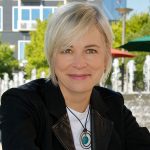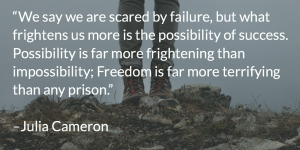
Nov 14, 2011 | Leadership

I’ve been thinking a lot about powerful questions lately. And how the potency lies in their simplicity and delivery.
In coaching, the power of a direct, concise, well-timed question evokes reflection and propels a client toward self-discovery and transformation. You know you’ve ‘got one’ when a coachee’s reaction goes something like this: “Wow. That’s a great question. Let me think about it for a minute.” Or, “Well, I never thought about it quite like that before…” Powerful questions halt you in your tracks and even make you uncomfortable. Your head tilts. Eyes squint. You grow quiet, contemplative.
In my experiences working with organizations, I’m reminded of a time when a particularly insightful and courageous individual asked precisely the right questions, spurring actions that changed an entire course (though in the moment they seemed unrelentingly stubborn and persistent).
In this particular case, I was working for the United Arts Council of Greater Greensboro. We were holding our monthly board meeting and reporting on financial results of a recent special event. These disappointing results, paired with other line-item budget-to-actual revenue shortfalls, painted a picture of concern. A financially savvy board member began firing a series of powerful questions, probing into current and prior year financial data.
Following this meeting and subsequent analysis, we began a review that ultimately revealed significant, cumulative direct and indirect revenue loss related to our events and also to other business functions that had failed to meet projections. Individually, each issue alone had quietly gone unnoticed or was of minor concern, but together the problems were steadily building. During the examination some reasoned, too, that we were distracted from a lack of focus.
I recall the general initial reaction to this individual’s inquiry as that of frustration, defense, and a sense of vulnerability – though over time, it evolved to one of gratitude. That day, the board member began to pull a thread that ultimately unraveled a series of issues that received immediate, priority attention, and we began crafting a strategy that changed our overall scope of work and the way we did business. All because one individual saw what others didn’t, or were afraid to question.
I’ve learned a lot from this and other experiences where I’ve witnessed powerful questions in action.
– Don’t be afraid to question. Chances are if you have a particular question, others probably have it too.
– Ask with a spirit of curiosity and sincerity. Great questions are selfless, not asked to illustrate the cleverness of the questioner, and are supportive, insightful, and challenging.
– Think before you ask. What do you want your question to accomplish? Intentionally frame your question so that you encourage collaborative thinking and cannot be perceived as threatening.
– Be succinct and direct. The powerful question is powerful because it cuts through to the heart of the issue. Short is good.
– Allow silence to do its work. Ask, then be quiet and wait. Pay attention to the impact of the questions you ask.

Oct 1, 2011 | Leadership

Do you recall your first formal leadership development experience?
My first experience was in 2000 – I was sponsored by a local foundation to participate in the Leadership Development Program at the Center for Creative Leadership (CCL). I was 30, and I had been working for nine years, building a career in the nonprofit sector.
Up to that point, my leadership development experiences had been more informal – in school, on the athletic field, and over years of music lessons – all through interactions with insightful teachers and coaches.
In the early years of my career, I received leadership training from various bosses, mentors, and other seasoned professionals in the form of sage advice, best practices, and – most often – “in the moment” life lessons at an operational, grassroots level. My ‘classroom’ was “on the street,” “in the trenches,” and oftentimes in sink or swim situations…some of the greatest learning opportunities there are.
At 30 years of age, most of my professional development occurred when wearing many hats, trying new things, taking risks, and making my best efforts to exhibit courage in the face of fear. Progress and discoveries came as much by failure as by success.
Today, colleges and universities have more formally developed leadership programs and offerings for students; many are course requirements for undergraduate study. Students graduating and entering the for-profit workplace often begin on a career development track and are exposed early on to corporate leadership training programs, assessments, and executive coaches.
These kinds of critical opportunities, while assumed and plentiful in the corporate environment, are glaringly absent in the nonprofit sector. And even if available, many leadership programs are cost-prohibitive for many small to medium-sized organizations.
My formal CCL experience was made possible by a new funding relationship between CCL and a local foundation partnering to sponsor nonprofit executives’ participation in the Center’s Leadership Development Program. For me, it was life-changing. It was the first time in my career that I was exposed to behavioral assessments, 360-degree feedback, insight into my natural and adapted leadership styles, and in-depth analysis of my strengths, weaknesses, and blind spots.
After that one-week intensive, I was different. Armed with new, critical insight, it was as if the Vaseline had been wiped from my windshield. My discoveries and newfound vision:
- Augmented my leadership, management, and decision-making capabilities.
- Sharpened my abilities to value, work with, and manage others.
- Spurred me to create a career vision and goals to chart and navigate my course.
- Fueled my desire to gain increasing responsibility, ultimately helping me achieve my goal of leading a nonprofit arts organization.
- Ignited my interest in seeking out additional opportunities, including books and articles on leadership, other continuing education, and connecting to coaches and mentors.
“What if I had had a similar kind of formal leadership development experience in high school, or college – or in the first year or two of my career? What difference would it have made in my professional development, how I interacted with co-workers, teams and boards, and in my overall career track? I know the difference it made at 30 years of age. What if I had had the same experience at 20?
Today, I can only imagine that impact. It has prompted my own drive to help make leadership coaching opportunities available and accessible for students and young professionals. I believe we must reach teachers, coaches, and other mentors interacting with our young people and ensure they have the skills and training necessary to take advantage of the critical leadership teaching moments in everyday experiences.
I’m discovering exciting ways to be involved in the creation and delivery of such opportunities, including participating in CCL’s Young Women’s Leadership Program, the University of North Carolina’s student mentoring program, and working to help coach and develop the next generation of arts and culture leaders.
I encourage you to begin where you are:
- Seek out formal leadership development for yourself – early on and often; I guarantee it will be an eye-opening experience and have countless positive effects on your life.
- Surround yourself with trusted and respected mentors and consider working with an executive coach. You’ll be more purposeful and mindful of your career and life path, taking charge of your present and future direction.
- Get involved in positively influencing the life, education, and/or career of a young adult. You’ll receive as much or more than you give!
- Advocate for leadership development within the nonprofit sector. Encourage it as a priority in your workplace, among peers, and to funders to invest in and support leadership development opportunities.
 About Jeanie Duncan: Jeanie is President of Raven Consulting Group, a business she founded that focuses on organizational change and leadership development in the nonprofit sector. She is a senior consultant for Raffa, a national firm working with nonprofit clients to lead efforts in sustainability and succession planning, executive transition and search. Additionally, Jeanie serves as adjunct faculty for the Center for Creative Leadership, a top-ranked, global provider of executive leadership education.
About Jeanie Duncan: Jeanie is President of Raven Consulting Group, a business she founded that focuses on organizational change and leadership development in the nonprofit sector. She is a senior consultant for Raffa, a national firm working with nonprofit clients to lead efforts in sustainability and succession planning, executive transition and search. Additionally, Jeanie serves as adjunct faculty for the Center for Creative Leadership, a top-ranked, global provider of executive leadership education.
Jul 1, 2011 | Career
A good friend and colleague once said to me, “You should always consider yourself ‘on the market.’” She offered this in the context of a conversation we were having about job searching, and the thoughts of beginning a search as if it’s an “event” – like a switch you flip or trigger you pull.
Job searching is a daunting process with a long list of tasks: revise resume, update Linked In, connect with your network, search the internet, prepare for interviews, and so on. Yet, if you embrace a mind shift and always think of yourself in marketing terms – product, supply, demand, audience – it removes some of that pressure.
Consider for a moment: If you’re perpetually ‘on the market,’ it implies you are ‘at the ready’ and poised for opportunities. Shouldn’t we all be? Afterall, if you don’t continually refine and sharpen your unique attributes, present and market yourself, who will? You are your #1 agent and champion. Position yourself as such.
– Refine your resume and have it ready for the right opportunity. Perhaps this is something you do annually or biannually, associated with your performance review.
– Maintain an updated Linked In, complete with the key words and phrases to showcase your attributes and attract your desired opportunity and direction.
– Be a serial networker, building relationships to develop your personal and professional capital among key people. Within your broader network of contacts, cultivate a smaller core of your closest allies. The more diverse (in terms of position, geography, skillset, etc.) that top group is, the better. It will extend your reach and influence.
– Perform at your best in the present moment while knowing what you want most for your future. Focus on that target, understanding that it continually evolves.
– If this target requires additional education or skill development, take steady action in small, achievable steps to acquire it so you’ll be ready.
– If an opportunity you seek is a significant shift, perhaps it’s in a different company division or a new industry altogether, find ways to connect and position yourself among the leadership and in the environments you desire.
– Know your top three to five strengths and be able to talk about them in terms of the value you can deliver. Resist the temptation to sell everything you can do. You’ll come across as a generalist and lessen your leverage.
– Identify and work with an executive coach. It’s an investment that will yield great dividends – an outside perspective to help you gain a greater sense of awareness and cultivate your own inner knowing to chart your course.

May 1, 2011 | Career, Transition & Change

For years, I’ve observed athletes, politicians, corporate executives, and colleagues maneuver through their careers advancing, transitioning, or retiring. I’ve admired those who always seemed to know when to make a change, and I’ve often felt frustrated by those who didn’t.
There are those who ride the wave until it crests. They stay in a job, continuing in a role that fits, delivering a great impact and return on their unique investment of creative talent. Then, with the same finesse with which they rode that wave, they ride smoothly to the next wave or opportunity. No matter where they are, their presence and leadership imbues their organizations with energy, enthusiasm, and inspiration – during their tenure and after.
Then there are those who never seem to “know when.” They advance and develop, making great contributions to their enterprise and the people it serves. Some receive numerous accolades for their achievements. Five years pass, then 10, 20, and even beyond, and they stay put. I know that a rare few can continue at the top of their game for extended periods, approaching their work with as much fresh energy, passion, and creativity as ever before. More often than not, however, this isn’t the case.
Staying in one spot for too long leaves them comfortable yet stale, feeling burned out and empty. Their flame went out years ago, and because they don’t “know when” – or more likely they do “know” but hold themselves back with fear and doubt – they engender that same lassitude within their environment and culture.
Over my 20 year career, I’ve always wondered, “How do those who know when, know when?”
It was 2008, and I was in my fifth year as President & CEO of the United Arts Council of Greater Greensboro and my twelfth with the organization overall. I found myself experiencing a sense of restlessness. When I first noticed it, I had no idea what it was or what was causing it; I had never felt anything quite like it before. I knew that above all else, it was persistent. I tried ignoring the sensation, passing it off as a nagging ache and drowning it with my work priorities and busy schedule. But it was like a kid sister continuously tapping on my shoulder.
So, I decided to stop fighting it and instead tuned in to it. I would lie awake at night, tossing and turning, and ask, “What is it? What are you trying to tell me?” I would go for a run, and as the day’s stress melted and my mind freed, I wondered: “Is it something to do with my family? My spouse? Work?” And on it went in my day-to-day activities and thoughts over several months. I’d query, wait, and try to listen.
I wish I could tell you that I had a clear and direct sense of “knowing when” (and knowing what), but it was more a steady growing awareness. Things would happen like meeting new people, having an unexpected outcome with a project, and seeing barriers spring up in one place while opportunities grew in another. Small shifts and events I originally thought to be unrelated and random, when considered in aggregate, were actually pointing me toward a new course.
Accompanying this emotional journey was a more tangible recognition that I had accomplished the major goals I had hoped to achieve for the United Arts Council: debt elimination, significant revenue growth, re-focusing of organizational priorities, creating a new business model, and shoring up board and staff leadership.
Eventually, the two paths intersected, and it became quite clear. I knew what. I knew when. And when was now.
I felt satisfied that I had completed what I had set out to do for the organization. Over those twelve years, I had offered my very best in leadership and service to the organization and its greater mission. The professional experience of leading the organization and its people was the highlight of my career to that point. It simply was time to depart and transition into what would come next…at that point, I had no idea what that would be. But I knew one thing for certain: I didn’t want to follow a traditional career path, moving on to lead another nonprofit arts organization.
 After much reflection and consultation with mentors and a career coach, I determined that the right course for me was to complete my tenure at the Arts Council and then take some time off. Clear my head. Explore some creative pursuits. And allow myself the space and time to renew my energy and shape what would come next. So I committed to a year-long sabbatical, and that journey began in December 2009.
After much reflection and consultation with mentors and a career coach, I determined that the right course for me was to complete my tenure at the Arts Council and then take some time off. Clear my head. Explore some creative pursuits. And allow myself the space and time to renew my energy and shape what would come next. So I committed to a year-long sabbatical, and that journey began in December 2009.
During my sabbatical, I came to believe it’s less about truly “knowing” and more about the courage to tune in to that “knowing,” trust it, and follow it. What prevents most from taking the leap is fear – a doubt in one’s own “personal capital” and self-worth.
Author Julia Cameron, in her book Artist’s Way, wrote that: “We say we are scared by failure, but what frightens us more is the possibility of success. Possibility is far more frightening than impossibility; Freedom is far more terrifying than any prison.”
After spending many years in a particular career or post, it’s easy to slip into the mindset of feeling trapped, but secure. You’re good at what you do, you’ve done it for a long time, and you’re compensated well. It’s natural to want to avoid stirring things up. Change will be challenging, most likely require making tough decisions, moving out of your comfort zone, learning something new, or even beginning a new venture. It’s easier to stick it out – you reason – despite your energy having fallen flat and your passion dimmed.
Possibility, potential, and capacity – tapping into those requires taking a leap of faith. I do recognize that deciding to tune in and take action on “knowing when” requires attention to many variables – timing, financial, family, etc. – all of which have to be considered. But jumping into the unknown is the only way we grow, develop, and realize our potential. If we don’t leap, we’ll never know what could be, or how much happier and more fulfilled we could be.
I am convinced that somewhere along the career track, everyone will experience this sense of “knowing when.” When you do, tune in to it, and take action on your instincts.
- Pay attention to the signs. When you sense burnout, boredom, or restlessness within yourself, move toward it, not away from it. Question why you have these feelings and what you could do to restore enthusiasm, energy, and passion.
- Consult with mentors, advisors, or a coach. An outside-in perspective offers an invaluable process of reflection, goal setting, and charting a course.
- Trust in yourself. If you don’t, no one else will. Inventory your greatest attributes and skills; consider these your key leverage points.
- Take action. If you don’t, how will you ever know “what could have been?” Making a significant change can seem overwhelming. Take the big picture and break it down into smaller pieces. Outline actions to take for each that will advance you closer to your ultimate goal.
 About Jeanie Duncan: Jeanie is President of Raven Consulting Group, a business she founded that focuses on organizational change and leadership development in the nonprofit sector. She is a senior consultant for Raffa, a national firm working with nonprofit clients to lead efforts in sustainability and succession planning, executive transition and search. Additionally, Jeanie serves as adjunct faculty for the Center for Creative Leadership, a top-ranked, global provider of executive leadership education.
About Jeanie Duncan: Jeanie is President of Raven Consulting Group, a business she founded that focuses on organizational change and leadership development in the nonprofit sector. She is a senior consultant for Raffa, a national firm working with nonprofit clients to lead efforts in sustainability and succession planning, executive transition and search. Additionally, Jeanie serves as adjunct faculty for the Center for Creative Leadership, a top-ranked, global provider of executive leadership education.







